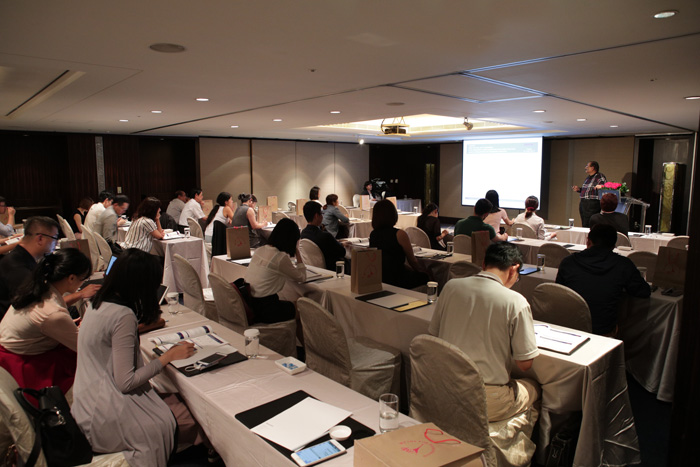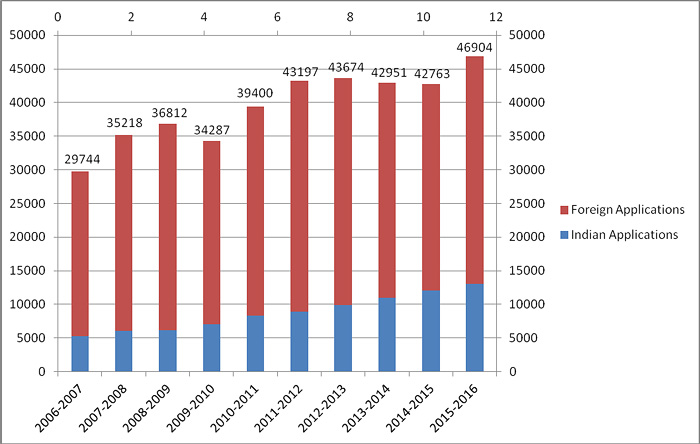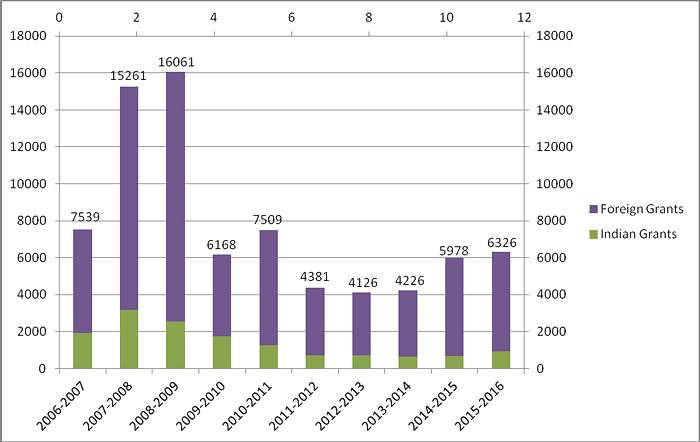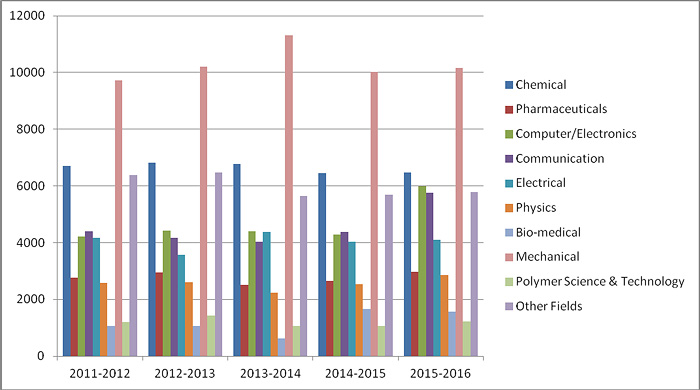|

Figure 1: The conference in Taipei
India is set to play a significant role in Taiwan’s New Southbound Policy with a dedicated trade office being set up there, but given that the focus of this revamped version of the previous Southbound Policy is focused more on bilateral cooperation and innovation, the state of India’s IPR system is a key factor in ensuring that the rights of Taiwanese companies investing there are protected.
Representatives from the firm D.P. Ahuja and Co. visited Taipei this month to provide an insider perspective on the patent and trademark system in India.
Ahuja prefaced his talk by stating his opinions about the way government works in India and the issues that this has caused. He stated that India’s government believes India to be ahead of everyone in every field, which makes them resistant to seeking help from outsiders. This result of this, he said, is that innovation and industry suffer. He went on to state that many of the issues with IP rights in India stem from the government’s view of them as monopolies. This means the patent system is geared around the idea of finding the best way not to grant patents, rather than being designed to allow for efficiency in patent grants. To this end, Ahuja said, “To an Indian examiner, everything is obvious,” which can make it more difficult to secure patent rights. On a more positive note, however, he said that this does not mean that patents are impossible to secure, but only that more effort is required on the part of the filing attorney. Part of the problem comes from India’s attempt to clear the backlog of applications with little extra effort on the behalf of the Intellectual Property Office itself. To this end they have hired examiner recruits with only a brief period of training, who tend to reject applications based on formalities, rather than putting a lot of thought into their reports. The bar has also been raised in terms of regulatory changes, which also apply retroactively to applications that have already been filed. On a more positive note, Ahuja stated that in his practice 95% of applications end up getting granted.
Perhaps it’s for this reason that Ahuja titled this section of his talk, “What is Still NOT PATENTABLE in India”.
Non-Patentable Subject Matter:
- Methods of therapeutic, medicinal, surgical and diagnostic treatment of human beings or animals
- “Use” claims, including Swiss-type “use” claims and first or second medicinal use of a known substance
- New forms of known substances [1]
- New properties of a known substance
- Product-by-process claims, wherein the product obtained by the claimed process is anticipated by any prior disclosure of that particular product regardless of method of production
- New compositions comprising combinations of known ingredients but not exhibiting any synergism or unexpected result [2]
- An agricultural or horticultural method
- Computer program unless claimed in combination with hardware that provides an improved technical effect over the prior art [3]
- Inventions relating to atomic energy
- Inventions relevant for defense purposes.
Ahuja stated that the restriction on new forms of known substances and on product-by-process claims were particularly regressive in terms of their impact on innovation.
Foreign applications make up the majority of applications filed to the Indian Patent Office as well as the majority of applications granted by the office, as can be seen from Figures 2 and 3.

Figure 2: Applications filed to the Office of the Controller General of Patents, Designs and Trademarks in the financial years 2006-2007 until 2015-2016; Source: Intellectual Property India, Annual Report 2015~2016, collated by Conor Stuart

Figure 3: Patent granted by the Office of the Controller General of Patents, Designs and Trademarks in the financial years 2006-2007 until 2015-2016; Source: Intellectual Property India, Annual Report 2015~2016, collated by Conor Stuart
The major fields in which patents were filed are in the last five financial years can be seen in Figure 4, to some extent reflecting the limits on patentability mentioned above.

Figure 4: Number of patent applications filed to the Office of the Controller General of Patents, Designs and Trademarks in the financial years 2011-2012 until 2015-2016 by major field of invention; Source: Intellectual Property India, Annual Report 2015~2016, collated by Conor Stuart
Points International Applicants Need to be Aware of:
Ahuja gave some tips for foreign patent applicants and holders of Indian patents of things that often trip up rights holders unfamiliar with the workings of the Indian intellectual property system.
Verified Translation of Priority Document
A verified English translation of the priority document must be provided at the time of filing the National Phase application for non-English language applications. If the translation is absent at time of filing, it must be submitted within three months of a request from the Controller otherwise the priority claim will be refused.
Foreign Filing License Under Section 39
Section 39 of the Indian Patent Act states that an inventor that is resident [4] in India cannot file a patent application (including a PCT application filed at the Indian Patent Office as the Receiving Office) abroad or cause such an application to be filed outside of India by his assignee without obtaining a Foreign Filing License or without first filing the application in India and waiting 6 weeks for any secrecy direction before filing an application abroad.
Filing of Proof of Right
A worldwide assignment certified or notarized as a true copy or an India-specific assignment executed by the inventor and signed by at least two witnesses and giving their full name and address should be submitted when filing a patent application in India where the inventor is not the applicant.
Details of Corresponding Foreign Applications and their Prosecution History
- Copies of granted patents
- English translation of granted claims of patents from non-English jurisdictions along with bibliographic details and prior art references cited during prosecution.
- Prior art references cited during the prosecution of pending counterpart foreign patent applications and claim amendments made to restrict the scope of claims to overcome objections against lack of novelty and/or inventive step
Timeline for Filing Divisional Application
No divisional application can be filed voluntarily with claims identical to or not patently distinct from those of the parent application in order to maintain patent rights. A divisional application can be filed only if there is a lack of unity of invention in the parent application. Divisional applications can only be filed while the parent application is pending.
Formal Hearing After Expiry of Final Last Date
Recently the patent office has issued final last date (6/9 months after first examination report issuance) hearing notices in place of the a second or third examination report.
Submission of Working Report for Granted Patents
A statement of working of the patented invention on a commercial scale in India has to be filed by the 31st March each year for the preceding calendar year. Reports have to be filed for all granted patents, even if there has been no commercial exploitation of the patent.
- New forms of known therapeutic substances can only be patented if they can be shown to improve the therapeutic efficacy.
- Examiners have discretion to judge “synergy”
- In practice, computer programmes have to be claimed in conjunction with novel hardware.
- A resident does not have to be a citizen, therefore this also applies to non-Indian staff of a foreign company resident in India.
 |
|
| Author: |
Conor Stuart |
| Current Post: |
Senior Editor, IP Observer |
| Education: |
MA Taiwanese Literature, National Taiwan University
BA Chinese and Spanish, Leeds University, UK |
| Experience: |
Translator/Editor, Want China Times
Editor, Erenlai Magazine |
|
|
|
| Facebook |
|
Follow the IP Observer on our FB Page |
|
|
|
|
|
|

